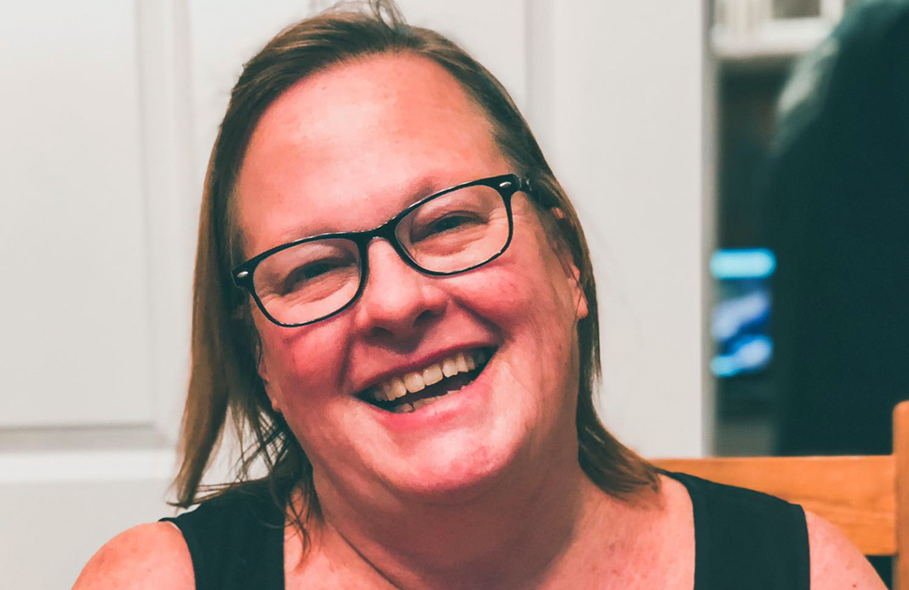Scholar-Practitioner: Kara Downs, Giving Students a Voice
by Tom Hanlon / Mar 1, 2021

Kara Downs, a longtime high school teacher, has returned to the College of Education to learn how to give minority students a greater voice in—and connection to—their education.
A high school English teacher for 22 years, Kara Downs is as enthused about her profession today as she was on Day 1.
That enthusiasm has prompted her to return to the University of Illinois, where she is working on her Ed.D. in Diversity & Equity in Education in the College of Education.
“I went back for more learning,” says Downs, who teaches at Centennial High School in Champaign. “Not to be an administrator; my heart is in the classroom. I figured if I got a doctorate, I could teach some courses at the collegiate level while remaining in the classroom.”
In addition to her primary role as an English teacher, Downs teaches a dual credit English class at Parkland College in Champaign, and for the past 15 summers she has taught a summer school English class to help high school sophomores who failed English recover credits and prepare for junior year English.
And she’s putting to use what she’s learning in her doctoral program through the Education Policy, Organization & Leadership (EPOL) department.
Using Critical Race Theory as Her Lens
“A lot of my classes in the program are looking at critical race theory and how you can use that as a lens to look at dual credit and Advanced Placement enrollments, to see why there’s such a low number of minorities in those classes,” Downs says.
Critical race theory offers an approach to understanding educational inequality and structural racism. The theory looks at practices that are taken for granted to uncover overt and covert racist ideologies and structures that maintain racial inequality.
In using that critical race theory lens, Downs sees more clearly some disconnects for minority students.
Seeing From the Students' Point of View
“I’ve always tried to bring in various voices in reading assignments, but it’s made me be much more specific about my choices,” she says. “I’ve had TAs of color saying ‘This is my experience in high school, and here’s what I wished I’d experienced instead.’”
For example, Downs says, she likes to put books in students’ hands that represent them. Then a black student in one of her PhD classes said, “I had a teacher that would always give me books with black characters, like she thought I couldn’t deal with anything else.” That made Downs examine her own practices.
“Someone once said books can be both a window and a mirror,” she says. “I was doing a lot of mirroring, and going too far in making assumptions. In my own reading practices, I read books with all different kinds of characters. I was making a choice for minority students that I wouldn’t have made for myself. It was a wakeup call.”
Giving Students Greater Ownership
In her most recent summer school class to help students recover credits—a class complicated by COVID-19 and an online-only format—Downs began using shorter pieces that the students could more readily engage with, and gave them a voice in choosing those pieces.
“They could read a Sports Illustrated article and use the claim-evidence-reasoning framework to explain what the author was saying, what the evidence is that he’s telling you that, and then to explain how effective or ineffective it was,” she says. “It was huge, because they saw they were not just doing this in a vacuum; they could apply it to things they’re interested in.”
This approach helped give the students more authority and ownership, she says.
Allowing Students to Use Their Own Voice
“I want to give my students a voice,” she explains. “The big idea 10-15 years ago was code switching, where the teacher says, ‘It’s great that that’s how you talk at home, but this is how we’re going to talk in the classroom.’ Black females in particular are told to be quiet a lot. They’re told they’re being too loud or disrespectful. I had to force myself to get past my own discomfort of my classroom being noisy. I needed to sit back and listen. The point is, it’s okay to be yourself in any space you’re in.
“And that was a huge change to my practice.”
That, Downs says, has been her overall biggest takeaway so far in her Ed.D. (online) work. “The critical race theory has taught me how important it is to give a voice to minority students and to their families as well,” she says.
The longtime teacher is still learning, and passing on what she learns. She is still using her voice to transfer knowledge to her students, and listening to their voices as she continues to impact the lives of all her students—and, so importantly, of minority students who previously have felt that no one was listening to them.
About the Scholar-Practitioner Series
The College of Education is profiling alumni to reveal how they are putting to use what they learned during their time in the College, and how that learning has impacted them in the field.